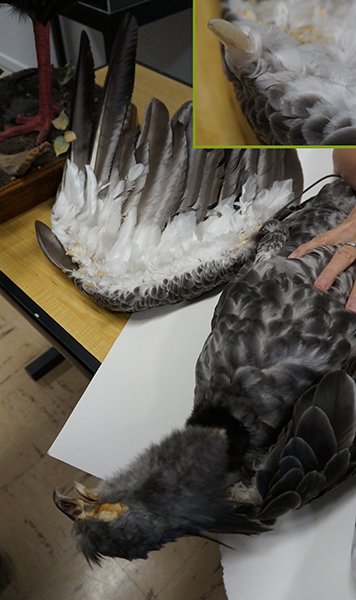A couple years ago, when someone asked my sister why she came to Darwin Discovery Day at MSU Museum, she pointed toward me and told the person interviewing her that it was because it was like a religious experience for her sister, who had a dragged her there. While she was exaggerating (a bit), I’m not exaggerating when I say Darwin Day, held annually in February, is amazing and anyone interested in natural science should be there. The event itself would be fun enough if the only extra museum activity involved checking out the critters brought by the MSU Herpetology Club and MSU Bug House, but there are so many activities I’ve never managed to get through all of them.

My favorite live animal was a toss-up between this adorable gargoyle gecko (look at those eyes!) and a small turtle that hid in its tank to avoid the crowds.
For me, the most exciting thing about Darwin Day is that once every year, people like me, who aren’t researchers, students, or museum employees, get to tour the museum’s research collections. Getting to take the elevator up to the third floor and get a behind-the-scenes look at mammoth bones found in Jackson County, specimen jars containing fish and handwritten labels, drawers full of tiny preserved bats and bat skeletons, and cabinets full of rare animal furs and skulls is an enjoyable little adventure, even if the smell is a bit overwhelming at times. Researchers around the world use the collection’s many thousands of specimens.
This year’s theme was “Teeth, Horns, Claws, Thorns: Nature’s Weapons.” Each year the tour guides bring out a few special pieces that fit the theme. This year, visitors passed around a very heavy but as-yet-unidentified petrified bone and got an up-close look at a preserved bird nest. We also learned that turtles cannot come out of their shells and got to see why — their spines are fused to the plates of their shells.
The herpetology collection houses jar after jar filled with a 70% ethanol solution and preserved animal specimens. Brightly colored snakes, fish, mammal fetuses, and other creepy-looking creatures fill row after row of shelves and cabinets. Some are very old, and visitors learned it was not unusual to find a decades-old Mott’s applesauce jar that had been put to a very different use than it was originally intended.

Screamers were among the bird specimens on display. They have spurs on their wings (inset) to help fend off rivals and predators.
My other favorite stop is the “Bug Room,” tucked away in a ground floor corner, but it’s currently undergoing renovations. I was told it should be reopened for tours in a year or two. Inside, a freezer-like box filled with beetles helps clean animal bones and there are freezers full of animal carcasses. Since zoos often donate the remains of their animals, there are sometimes exotic fauna in the mix (a few years ago we saw an otherworldly-looking giraffe skull).
There are many hands-on activities for kids stationed throughout the museum. I watched kids “ooh” and “ahhh” over hissing cockroaches from MSU Bug House and a few brave souls let a tarantula crawl on them.
Volunteers were very patient with children’s many questions and sometimes-rough handling of the stuffed bird specimens. Kids were also busy making origami birds or checking out the horns, bones and rocks laid out for them to handle.
The MSU Beacon Center for the Study of Evolution in Action was well represented, including a computer simulation that demonstrated evolution in action. My sweetheart and I didn’t make it to the planting stations or the birthday cake this year, but we saw many people wandering around with their plantings in hand. One of these years I hope to make it through everything Darwin Discovery Day has to offer. I’ll be trying again next year.

I had no idea what animal this skeleton belonged to. Turns out it was a black bear from Michigan. They look much less imposing without the fur.

Illegal items confiscated at the Detroit airport are donated to museums since they cannot leave the state where they were taken. Samples of ivory, sea turtles (including a pair of turtle skin boots), feathers, and a 10-foot tiger skin were among the contraband on display.

This is just a tiny sample of the thousands of study skins and skulls available for researchers. I was happy to hear animal specimens died as a result of natural causes — hunting to procure museum specimens fell out of favor in the 1950s.




Love this!!! THANK YOU for an exceptional story!
Fun article! ‘d never even heard of this. How do they get the word out before the event?
Barb, I think I found out about it from the Greater Lansing Convention & Visitors Bureau years ago. I know they share it on the museum’s Facebook page, but I get updates through their snail mail list.